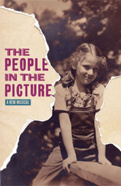Broadway Bookwriter Iris Rainer Dart on Her Intensely Personal The People in the Picture
About the author:
Author Iris Rainer Dart knows the advantage of a good adaptation—her second novel was the bestseller-turned-blockbuster film Beaches—so when she set her sights on writing the book of a Broadway musical, it would have been easy to plumb her existing work for material. Instead, she plumbed the depth of her own experience to create The People in the Picture, the story of a grandmother in 1970s New York City who shares stories of her years as a Yiddish theater and film star in pre-World War II Poland, including the difficult choices she made as the Holocaust loomed. Two-time Tony winner Donna Murphy is currently tackling this complex character in Roundabout Theatre Company's production at Studio 54. Below, Dart shares the creation story of this tale, steeped in her family history and identity as a Jewish woman.
![]()
Both my mother and my father were immigrants. My mother came to America from Russia and my father from Lithuania. They spoke more Yiddish in our Pittsburgh, Pennsylvania, house than they did English. My father put himself through college and became a social worker in a Settlement House in Pittsburgh’s Hill District, a neighborhood which was later made famous by August Wilson in his wonderful plays. We had no money. We were always behind on payments to the phone company, the utilities and the grocery store. Even as a very young child, I somehow knew that. But I also knew we had something money couldn’t buy: a group sense of humor that enabled us to laugh at all adversity. So my memories of my childhood are about laughing, telling jokes and singing. The Yiddish culture and the Yiddish language are filled with humor. When I started this project, I wanted to tell the story of how passing on the best parts of our culture is a gift we can give to our children and our grandchildren.
About 15 years ago (yes, that long), I sent away to a company that was advertising Yiddish films and ordered several that were made in Poland between the wars. When they arrived, I sat on the floor of my bedroom watching them and weeping. First, because even after so many years of not hearing the language, I didn’t need to read the subtitles because I understood the Yiddish. But I also wept because I knew in retrospect what the Jews in Poland were going through at the time with both the Nazi threat and anti-Semitism in Warsaw. I found it remarkable: There they were, making films that were musical and funny and filled with charm, celebrating their Jewishness. It was a form of cultural resistance I both admired and wanted to study.
Delving into the subject of humor during the war, I found many sources. Some of the stories were in books, but other stories came directly from the mouths of survivors of the ghettos and the camps. One woman in particular, Silvia Martin, was a volunteer at Steven Spielberg’s Shoah Foundation. She had been in Auschwitz, and we spent many hours together during which she told me of many incidents of humor she and her friends shared. I was astounded and interested and kept researching. A book called Laughter in Hell chronicled the irreverent jokes the prisoners of the ghetto shared. I realized that one of the best things about my own heritage was the ability to find the humor in any situation. And because I learned to do that, I became a comedy writer.
I was the only woman writer on the staff of Cher’s solo TV debut and the first woman writer on the Sonny and Cher show. It was the 1970s, not a time when male comedy writers wanted a woman in the room. But I held my own. George Schlatter, the producer, was quoted in one article as saying about me, “She pitches in a room, like a man.” That was a compliment in those days. That experience helped me to create the character of Red, the daughter in The People in the Picture, a woman who had to be tough in order to survive not only her difficult mother, but her demanding career.
I was able, through friends, to meet Mike Stoller and Artie Butler, two brilliant tunesmiths, both of whom had written melodic, memorable songs over the years, and they each took to the material immediately. We are all well, over 60, with much life experience to draw on for the material, and Leonard Foglia (who never reveals his age) came onboard very early in the process to breathe much life into it. I know I can say, without fear of contradiction, that unlike many families of creatives, we are and have been a happy one. Roundabout, with the brilliant Todd Haimes at the helm, took a risk doing a musical not based on a film, not based on a cartoon character, but original from start to finish. Lucky us!
During the many years that I worked on this project, I became a grandmother, twice. My grandson will soon be eight years old and my granddaughter will be six. Maya is a little young to see a show of this nature, but Jonathan came to see it. The day he sat in the orchestra with his aunt, my daughter, I sat in the mezzanine filled with joy, knowing this was something I was passing on to him and for him.
“Bubbie,” he said to me later (a sophisticated theatergoer, this was his sixth Broadway musical), “The People in the Picture rocks!!” Amen.
Related Shows
Articles Trending Now
- Lea Michele’s New Tour Is a Musical Memoir 30 Years in the Making
- Inside the Black-and-White Ball: Photos of George Clooney and Good Night, and Good Luck’s A-List-Filled Broadway Opening
- The Last Five Years Through the Years: Veteran Cathys and Jamies Reflect as the Musical Two-Hander Lands on Broadway
